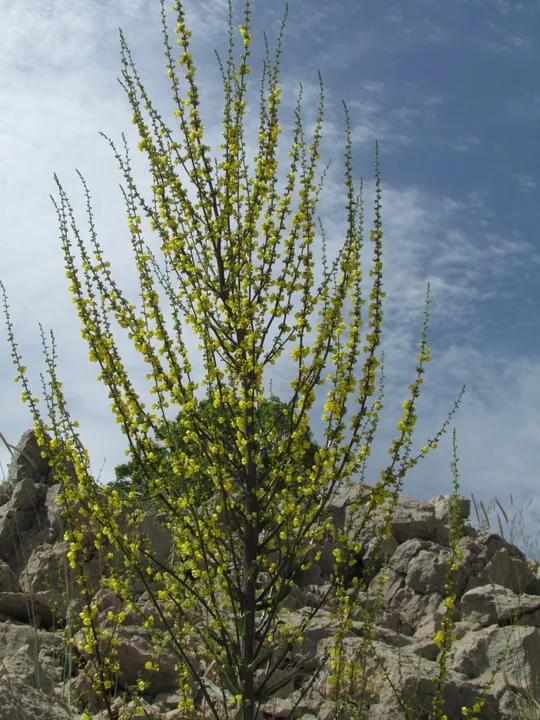Little Yellow Toadflax
Linaria simplex



Linaria simplex is currently found with certainty in
the Upper Galilee and the Golan Heights. The species grows on two sites in Israel,
although according to estimates there are three sites. In the Upper Galilee it
is known today only from Mount Shfanim and in the northern Golan Heights – from
Mount Avital. It also appears on Mount Hermon, which is outside the
geographical area with which this book deals with, in a scattered distribution pattern
in open montane forest at altitudes of 1500-1700 m.
Linaria simplex appears in
varied habitats: shrubland and at the edges of Mediterranean Quercus woodland,
herbaceous Mediterranean vegetation on basalt and montane transition zone Q.
boissieri and Q. libani forests. The same is true in other parts of
its range where L. simplex appears in
diverse habitats: fallow and cultivated fields, traditionally managed orchards
and different types of shrubland.
For the genus – see Linaria pelisseriana.
The species is close and similar to L. micrantha
that is scattered widely throughout the Mediterranean region and transition
zone, but differs from it in its distinct bluish-purplish flowers. L. simplex is very similar
to L. tenuis
that is found on the coastal plain sands and in the Negev. L. tenuis has tuberculate seeds that are not discoid. In
Israel, L. simplex
and L. tenuis are the only species that have tiny yellow flowers in the Linaria
genus.
L. simplex has a vicarious species in Europe –
L. arvensis, which differs from L. simplex by its straight spur and
a denser inflorescence. Together with L.
micrantha and L. pelisseriana these Linaria
species belong to the Discoideae section, which have discoid seeds and membranous
wings. L. tenuis, L. haelava and L. albifrons belong to another section,
Oblonga, whose seeds have 3-4 angles and no membranous wings. The great
similarity between the flowers of these two sections can be explained by
convergent evolution (similar traits evolving in different taxons) of the
flower and spur morphology and the adaptation of the flower to low rates of
cross-pollination. This appears in annual species whose geographic distribution
partially overlaps and is not usually found in perennial species.
Until recently Linaria simplex was considered a random species in Israel, but following its
discovery in the Mount Meron block a number of times, it is now considered as a
resident species and is included in the list of “Red” species.
·
L. simplex is extremely rare in the northern
regions of Israel.
·
Usually only a few individual plants are
found at each site.
·
Small populations are subject, by
virtue of their small size, to the threat of local extinction, although there
is a lack of information regarding their reproduction, demography and seed bank.
·
The Mount Shfanim site is located in
the Mount Meron reserve. Mount Avital is not a declared nature reserve.
·
L. simplex has a broad distribution and is probably
not globally endangered.
The Linaria simplex population on Mount
Shfanim should be regularly monitored to study the biology and demography of the
species.
Linaria simplex is a broadly distributed species found from
west of the Mediterranean to the Caucasus. It is found in Morocco, Spain,
France, Italy (including Sicily), all of Greece, western and northern Turkey,
Syria (both Mediterranean and in the Syrian Desert), Cyprus (rare), northern
Israel (extremely rare), Egypt (Southern Sinai mountains), southern Russia,
Georgia, Armenia, Azerbaijan and Iran (Gabrielian & Fragman-Sapir, 2008; Davis,
1978).
Linaria simplex is an annual
plant found in the Upper Galilee, northern Golan Heights and the Hermon. It is
very rare and found only at one site in each region. Previously considered a random
species, but repeated observations indicate its regular presence in the
country. There is a lack of information on the biology and ecology of the
species in Israel.
Gabrielian & Fragman-Sapir, 2008 Flowers of the Transcaucasus and Adjacent Areas. Gartner Verlag. Pp. 374-375.
Current Occupancy Map
| 1000 squre meter pixel | 5000 squre meter pixel | 10000 squre meter pixel | |
|---|---|---|---|
| number of observations | 0 | 0 | 0 |
| in total pixels | 0 | 0 | 0 |
| Family | Scrophulariaceae |
| Classification | On the extremely rare species list |
| Ecosystem | Mediterranean |
| Chorotype | Mediterranean (Irano-Turanian) |
| Conservation Site | Mount Shfanim in Mount Meron Nature Reserve |
| Rarity |
1
3
6
|
|---|---|
| Vulnerability |
0
0
4
|
| Attractiveness |
0
0
4
|
| Endemism |
0
0
4
|
| Red number |
1
1.6
10
|
| Peripherality | 0 |
| IUCN category | DD EW EX LC CR EN VU NT |
| Threat Definition according to the red book | Least concern |
 Based on:
Based on:






